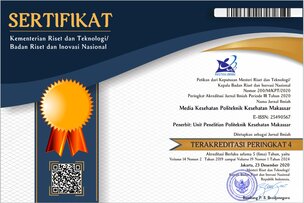FORMULATION AND ANTIBACTERIAL ACTIVITY TEST OF HAND SANITIZER ETHANOL EXTRACT OF BASIL (Ocimum Sanctum. L) AGAINST Escherichia coli dan Streptococcus Aureus
Abstract
Basil leaves (Ocimum sanctum L) Against to inhibit the growth of Escherichia coli and Staphylococcus aureus bacteria to increase its effectiveness, it is made in practical and easy-to-use preparations. One of the effective dosage forms for topical use is Hand Sanitizer. The factor that influences the quality of gel preparations is Carbopol as a gelling agent. To know the antibacterial effect and ethanol extract concentration of basis leaves (Ocimum sanctum L). preparation of Hand sanitizer, in which the selection and type of carbopol concentration will determine the stability of the gel formed. Basil leaf extract was obtained by maceration method using 96% ethanol solvent. The product is formulation in the form a gel Hand sanitizer with the addition of carbopol as a gelling agent with a concentration of 1,5% this type of research is laboratory Experiment with Stability Test, Organoleptic Test, pH, Homogeneity and Scattering power and Antibacterial Test on Escherichia coli and Staphylococcus aureus. For testing antibacterial activity the method used is the diffusion method. Form the research results obtained antibacterial Hand sanitizer preparations with concentration of 1%, 3% and 5% showed changes in odor , color and shape before and after storage at pH 4,8- 6,4. Organoleptic testing showed no changes in odor, color and shape before and after accelerated storage. pH testing shows charges before and after storage are caused by temperature light factors. Homogeneity testing showed no changes before and after storage. Scatter tests indicate changes before and after storage caused by temperature light factors. Antibacterial activity test shows that the formulation of Hand sanitizer ethanol extract of basil leaves (Ocimum sanctum L) with a concentration of 1%, 3% and 5%. can inhibit the growth of Escherichia coli and Staphylococcus aureus with Medium -Strong inhibitory zones. From the results of research conducted it was concluded that the antibacterial Hand sanitizer ethanol of basis was physically and chemically stable for Organiletic, pH, Homogeneity and Scattering effects.
Keywords
Full Text:
PDF (Full Text)References
Ansel,H.C., (2011) .Bentuk Sediaan Farmasetik dan Sistem Penghantaran Obat, Edisi V,Jakarta EGC.
Ansel, H. C., (1989). Pengantar Bentuk Sediaan Farmasi, Edisi Keempat, Jakarta, UI Press.
Allen, L., V., dan Ansel H. C. (2014). Ansel’s Pharmaceutical Dosage Forms and Drug Delivery Systems. Tenih Edition. Philadelpia: Lippincott Williams & Wilkins.
Astuti, D, D, (2012). Formulasi Sediaan Gel Etanol Buah Mahkota Dewa (Phaleria macrocarpa (sheff). Boerl). Dengan Basis HPMC, Skripsi, Fakultas Farmasi Universitas Muhamadiyah Sukarakarta.
Asngad Aminah, dkk 2018. Kualitas GelPembersih Tangan (Hand Sanitizer) Dari Ekstrak Batang Pisang dengan Penambahan Alkohol,Triloksan dan Gliserin yang berbeda dosisnya. Prodi Pendidikan Biologi FKIP Universitas Muhammadiyah Surakarta.
Dewi, K, I., dan Bambang, Y. (2016). Uji Efektivitas Sediaan Hand Sanitizer Kombinasi Ekstrak Daun Kemangi (Ocinum sanctum) Dan Ekstrak Kulit Jeruk Purut (Citrus hystrix). Kementrian Kesehatan Politeknik Kesehatan Surakarta Jurusan Jamu.
Dirjen POM. 2000. Parameter Standar Umum Ekstrak Tumbuhan Obat. Departemen Kesehatan Republik Indonesia. Jakarta.
Entjang Indan, (2001). Mikrobiologi dan Parasitologi. Untuk Akademik Keperawatan Dan Sekolah Tenaga Kesehatan Yang Sederajat.
Hanani Endang. (2014). Analisis Fitokimia, Penerbit Buku Kedokteran, Jakarta, EGC.
Hasdianah, (2012). Mikrobiologi untuk mahasiswa Kebidanan, Keperawatan, dan Kesehatan Masyarakat. Yogyakarta.
Kusuma Weda. (2010). Efek Ekstrak Daun Kemangi (Ocimum sanctum L.) Terhadap Kerusakan Hepatositis Mencit Akibat Minyak Sawit Dengan Pemanasan Berulang. Skripsi, Fakultas Kedokteran Universitas Sebelas Maret Surakarta.
Keumalasari, Kartini Hasballah, Imran. (2017). Promosi Kesehtan Cuci Tangan Dan Jajanan Sehat Terhadap pengetahuan Dan Sikap siswa. Jurnal Ilmu Kesehatan, Universitas Syiah kuala, Darussalam, Banda Aceh.
Lachman L., Lieberman H. A. and King J. L., (1994). Teori dan Praktek Farmasi Industri II, 3rd ed., Universitas Indonesia Press, Jakarta.
Lukman Agustianto, (2016). UJI Aktivitas Antibakteri Ekstrak Daun Kemangi (Ocimum sanctum L) Terhadap Bakteri Patogen Dengan Metode KLT Bioautografi. Fakultas Kedokteran Dan Ilmu Kesehatan Universitas Islam Negeri Alauddin Makassar, Makassar.
Mukhriani (2014). Ekstraksi,Pemisahan Senyawa, Dan Identifikasi Senyawa Aktif. Jurnal Kesehatan, Program Studi Farmasi, Fakultas Ilmu Kesehatan UIN Alauddin Makassar. Makassar.
Nadim Muhmad. (2011). Perbandingan Efek Diuresis Ekstrak Etanol Daun Kemangi (Ocimum sanctum L.) Dengan Hidroklorotiazid Pada Tikus Putih Jantan (Rattus norvegicus), Skripsi, Fakultas Kedokteran Universitas Sebelas Maret Surakarta.
Risnawaty Gracia, (2016). Faktor Determinan Perilaku Cuci Tangan Pakai Sabun (CTPS) Pada Masyarakat Di Tanah Kalikediding. Jurnal Promkes, Fakultas Kesehatan Masyarakat Universitas Airlangga.
Ristina., Mirnawati sudarwanto., dan letje Wientarsih. (2015). Aktivitas Antibakteri Ekstrak Etanol Daun Kari (Murraya koenigii) Terhadap Staphylococcus aureus, Escherichia coli, dan Pseudomonas sp. Jurnal Kedokteran Hewan Syiah kuala, Banda Aceh.
Rowe, Raymond C. et AL. (2009). Handbook Of Pharmaceutical Excipients, 5th Ed,The Pharmaceutical Press, London.
Rowe, Raymond C. et AL. (2009). Handbook Of Pharmaceutical Excipients, 6th Ed,The Pharmaceutical Press, London.
Setiadi, (2007). Anatomi Fisiologi Manusia. Graha Ilmu. Yogyakarta.
Syaiful,. D, S. (2016). Formulasi Dan Uji Stabilitas Fisik Gel Ekstrak Etanol Daun Kemangi (Ocimum sanctum) Sebagai Sediaan Hand Sanitizer, Skripsi, Fakultas Kedokteran Dan Ilmu Kesehatan Universitas Islam Negeri Alauddin Makassar.
Shu, melisa. Formulasi Sediaan Gel Hand Sanitizer dengan Bahan Aktif Triloksan 0,5% dan 1%. Universitas Surabaya Vol.2 No.1. 2013.
Sutiknowati Indah Lies, (2016). Bioindikator Pencemar, Bakteri Escherichia Coli
DOI: https://doi.org/10.32382/medkes.v15i2.1764
Refbacks
- There are currently no refbacks.
Copyright (c) 2020 Media Kesehatan Politeknik Kesehatan Makassar

This work is licensed under a Creative Commons Attribution-NonCommercial-NoDerivatives 4.0 International License.
Published By : Poltekkes Kemenkes Makassar
Office : Jl. Wijaya Kusuma Raya No. 46 Banta-Bantaeng, Kota Makassar, Sulawesi Selatan, Indonesia
Email : mediakesehatan@poltekkes-mks.ac.id
Media Kesehatan indexed by :
Protected By  |  |

This work is licensed under a Creative Commons Attribution-NonCommercial-ShareAlike 4.0 International License.




